可来复-泮托拉唑钠肠溶片-店员
- 格式:pptx
- 大小:2.49 MB
- 文档页数:25
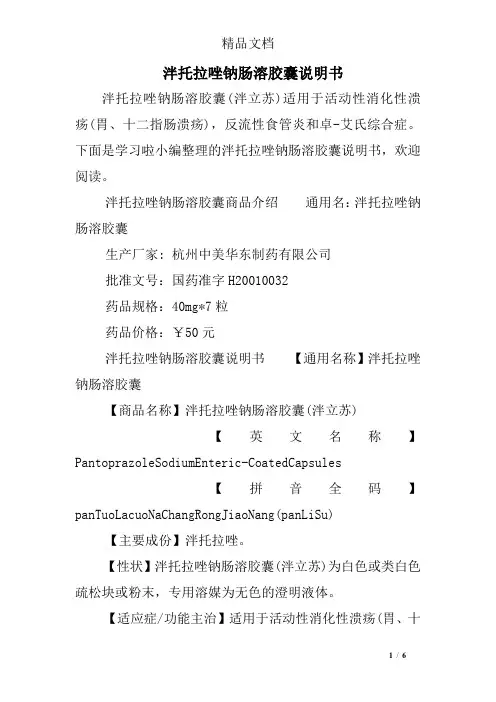
泮托拉唑钠肠溶胶囊说明书泮托拉唑钠肠溶胶囊(泮立苏)适用于活动性消化性溃疡(胃、十二指肠溃疡),反流性食管炎和卓-艾氏综合症。
下面是学习啦小编整理的泮托拉唑钠肠溶胶囊说明书,欢迎阅读。
泮托拉唑钠肠溶胶囊商品介绍通用名:泮托拉唑钠肠溶胶囊生产厂家: 杭州中美华东制药有限公司批准文号:国药准字H20010032药品规格:40mg*7粒药品价格:¥50元泮托拉唑钠肠溶胶囊说明书【通用名称】泮托拉唑钠肠溶胶囊【商品名称】泮托拉唑钠肠溶胶囊(泮立苏)【英文名称】PantoprazoleSodiumEnteric-CoatedCapsules【拼音全码】panTuoLacuoNaChangRongJiaoNang(panLiSu)【主要成份】泮托拉唑。
【性状】泮托拉唑钠肠溶胶囊(泮立苏)为白色或类白色疏松块或粉末,专用溶媒为无色的澄明液体。
【适应症/功能主治】适用于活动性消化性溃疡(胃、十二指肠溃疡),反流性食管炎和卓-艾氏综合症。
【规格型号】40mg*7s【用法用量】口服,每日早晨餐前一粒(40mg)。
十二指肠溃疡疗程通常为2-4周,胃溃疡和反流性食管炎疗程通常为4【不良反应】偶见头晕、失眠、嗜睡、恶心、腹泻、便秘、皮疹和肌肉疼痛等症状。
大剂量使用时可出现心律失常、氨基转移酶升高、肾功能改变、粒细胞降低等。
【禁忌】对泮托拉唑钠肠溶胶囊(泮立苏)过敏者禁用;妊娠期与哺乳期妇女禁用。
【注意事项】①泮托拉唑钠肠溶胶囊(泮立苏)抑制胃酸分泌的作用强,时间长,故应用泮托拉唑钠肠溶胶囊(泮立苏)时不宜同时再服用其他抗酸剂或抑酸剂。
为防止抑酸过度,在一般消化性溃疡等病时,不建议大剂量长期应用(卓-艾综合征例外)。
②肾功能受损者不须调整剂量;肝功能受损者需要酌情减量。
③治疗胃溃疡时应排除胃癌后才能使用泮托拉唑钠肠溶胶囊(泮立苏),以免延误诊断和治疗。
④动物实验中,长期大量使用泮托拉唑钠肠溶胶囊(泮立苏)后,观察到高胃泌素血症及继发胃ECL-细胞增大和良性肿瘤的发生,这种变化在应用其他抑酸剂及施行胃大部切除术后亦可出现。
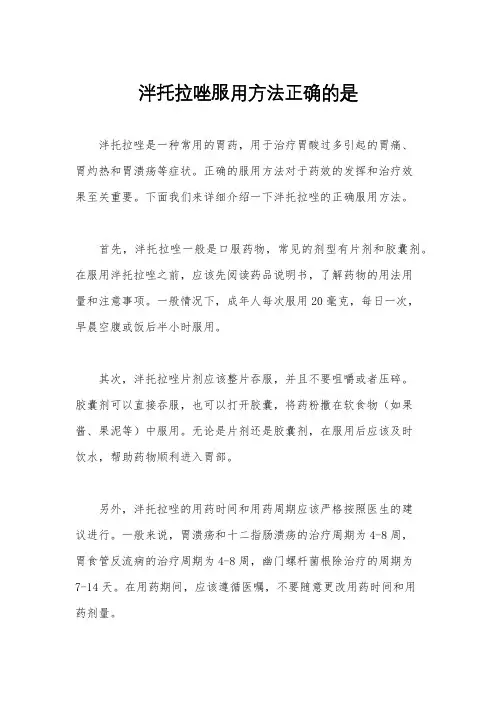
泮托拉唑服用方法正确的是泮托拉唑是一种常用的胃药,用于治疗胃酸过多引起的胃痛、胃灼热和胃溃疡等症状。
正确的服用方法对于药效的发挥和治疗效果至关重要。
下面我们来详细介绍一下泮托拉唑的正确服用方法。
首先,泮托拉唑一般是口服药物,常见的剂型有片剂和胶囊剂。
在服用泮托拉唑之前,应该先阅读药品说明书,了解药物的用法用量和注意事项。
一般情况下,成年人每次服用20毫克,每日一次,早晨空腹或饭后半小时服用。
其次,泮托拉唑片剂应该整片吞服,并且不要咀嚼或者压碎。
胶囊剂可以直接吞服,也可以打开胶囊,将药粉撒在软食物(如果酱、果泥等)中服用。
无论是片剂还是胶囊剂,在服用后应该及时饮水,帮助药物顺利进入胃部。
另外,泮托拉唑的用药时间和用药周期应该严格按照医生的建议进行。
一般来说,胃溃疡和十二指肠溃疡的治疗周期为4-8周,胃食管反流病的治疗周期为4-8周,幽门螺杆菌根除治疗的周期为7-14天。
在用药期间,应该遵循医嘱,不要随意更改用药时间和用药剂量。
最后,泮托拉唑在服用过程中可能会出现一些不良反应,如头痛、恶心、腹泻等。
如果出现严重不良反应,应该立即就医。
同时,泮托拉唑可能会与其他药物发生相互作用,影响药效,因此在用药期间应避免与其他药物混合使用,或者在医生指导下合理搭配用药。
总之,正确的泮托拉唑服用方法对于治疗胃部疾病非常重要。
在服用泮托拉唑之前,应该仔细阅读药品说明书,了解用药方法和注意事项。
在用药过程中,应该严格按照医生的建议进行,不要随意更改用药时间和用药剂量。
如果出现不良反应或者药物相互作用,应该及时就医。
希望大家能够正确使用泮托拉唑,早日康复。
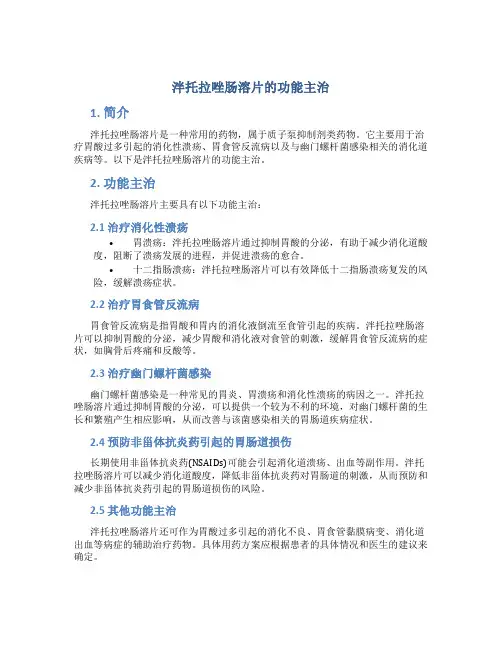
泮托拉唑肠溶片的功能主治1. 简介泮托拉唑肠溶片是一种常用的药物,属于质子泵抑制剂类药物。
它主要用于治疗胃酸过多引起的消化性溃疡、胃食管反流病以及与幽门螺杆菌感染相关的消化道疾病等。
以下是泮托拉唑肠溶片的功能主治。
2. 功能主治泮托拉唑肠溶片主要具有以下功能主治:2.1 治疗消化性溃疡•胃溃疡:泮托拉唑肠溶片通过抑制胃酸的分泌,有助于减少消化道酸度,阻断了溃疡发展的进程,并促进溃疡的愈合。
•十二指肠溃疡:泮托拉唑肠溶片可以有效降低十二指肠溃疡复发的风险,缓解溃疡症状。
2.2 治疗胃食管反流病胃食管反流病是指胃酸和胃内的消化液倒流至食管引起的疾病。
泮托拉唑肠溶片可以抑制胃酸的分泌,减少胃酸和消化液对食管的刺激,缓解胃食管反流病的症状,如胸骨后疼痛和反酸等。
2.3 治疗幽门螺杆菌感染幽门螺杆菌感染是一种常见的胃炎、胃溃疡和消化性溃疡的病因之一。
泮托拉唑肠溶片通过抑制胃酸的分泌,可以提供一个较为不利的环境,对幽门螺杆菌的生长和繁殖产生相应影响,从而改善与该菌感染相关的胃肠道疾病症状。
2.4 预防非甾体抗炎药引起的胃肠道损伤长期使用非甾体抗炎药(NSAIDs)可能会引起消化道溃疡、出血等副作用。
泮托拉唑肠溶片可以减少消化道酸度,降低非甾体抗炎药对胃肠道的刺激,从而预防和减少非甾体抗炎药引起的胃肠道损伤的风险。
2.5 其他功能主治泮托拉唑肠溶片还可作为胃酸过多引起的消化不良、胃食管黏膜病变、消化道出血等病症的辅助治疗药物。
具体用药方案应根据患者的具体情况和医生的建议来确定。
3. 使用注意事项在使用泮托拉唑肠溶片时,需要注意以下事项:•用药剂量、频次和疗程应严格按照医生的处方和指导来进行,不可自行增加或减少剂量。
•孕妇、哺乳期妇女、儿童、老年人等特殊人群在使用前需咨询医生。
•对泮托拉唑或其他质子泵抑制剂过敏者禁用。
•与其他药物同时使用时,需告知医生,避免出现不良反应或药物相互作用。
•在用药期间,应避免饮用含酒精的饮料、吃辛辣食物,以及避免吸烟等刺激性因素。
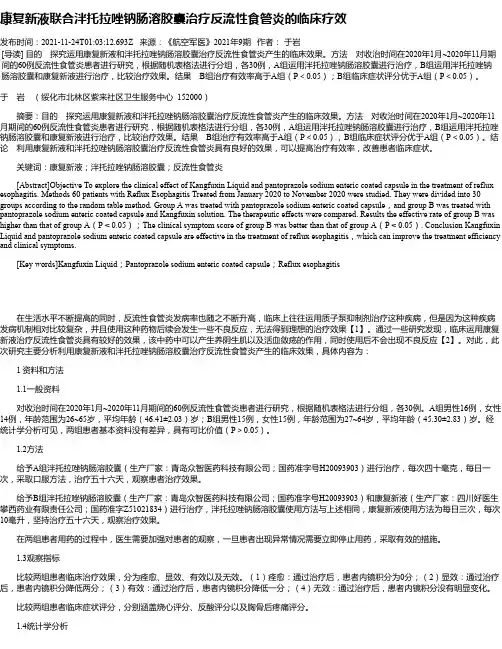
康复新液联合泮托拉唑钠肠溶胶囊治疗反流性食管炎的临床疗效发布时间:2021-11-24T01:03:12.693Z 来源:《航空军医》2021年9期作者:于岩[导读] 目的探究运用康复新液和泮托拉唑钠肠溶胶囊治疗反流性食管炎产生的临床效果。
方法对收治时间在2020年1月~2020年11月期间的60例反流性食管炎患者进行研究,根据随机表格法进行分组,各30例,A组运用泮托拉唑钠肠溶胶囊进行治疗,B组运用泮托拉唑钠肠溶胶囊和康复新液进行治疗,比较治疗效果。
结果B组治疗有效率高于A组(P<0.05);B组临床症状评分优于A组(P<0.05)。
于岩(绥化市北林区紫来社区卫生服务中心 152000)摘要:目的探究运用康复新液和泮托拉唑钠肠溶胶囊治疗反流性食管炎产生的临床效果。
方法对收治时间在2020年1月~2020年11月期间的60例反流性食管炎患者进行研究,根据随机表格法进行分组,各30例,A组运用泮托拉唑钠肠溶胶囊进行治疗,B组运用泮托拉唑钠肠溶胶囊和康复新液进行治疗,比较治疗效果。
结果B组治疗有效率高于A组(P<0.05);B组临床症状评分优于A组(P<0.05)。
结论利用康复新液和泮托拉唑钠肠溶胶囊治疗反流性食管炎具有良好的效果,可以提高治疗有效率,改善患者临床症状。
关键词:康复新液;泮托拉唑钠肠溶胶囊;反流性食管炎[Abstract]Objective To explore the clinical effect of Kangfuxin Liquid and pantoprazole sodium enteric coated capsule in the treatment of reflux esophagitis. Methods 60 patients with Reflux Esophagitis Treated from January 2020 to November 2020 were studied. They were divided into 30 groups according to the random table method. Group A was treated with pantoprazole sodium enteric coated capsule,and group B was treated with pantoprazole sodium enteric coated capsule and Kangfuxin solution. The therapeutic effects were compared. Results the effective rate of group B was higher than that of group A(P < 0.05);The clinical symptom score of group B was better than that of group A(P < 0.05). Conclusion Kangfuxin Liquid and pantoprazole sodium enteric coated capsule are effective in the treatment of reflux esophagitis,which can improve the treatment efficiency and clinical symptoms.[Key words]Kangfuxin Liquid;Pantoprazole sodium enteric coated capsule;Reflux esophagitis在生活水平不断提高的同时,反流性食管炎发病率也随之不断升高,临床上往往运用质子泵抑制剂治疗这种疾病,但是因为这种疾病发病机制相对比较复杂,并且使用这种药物后续会发生一些不良反应,无法得到理想的治疗效果【1】。
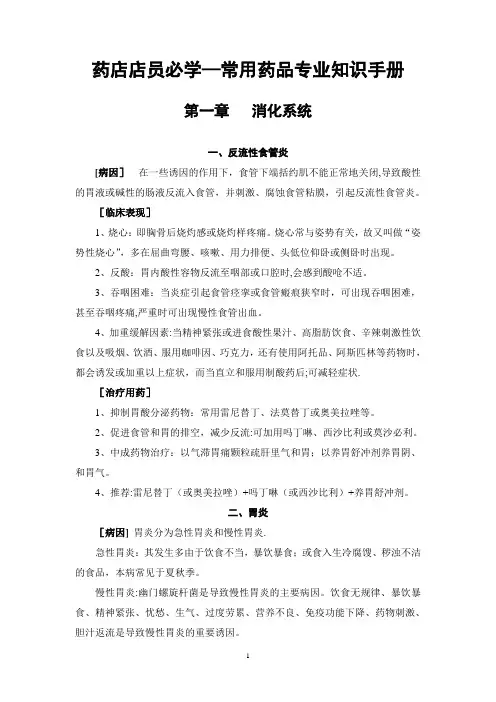
药店店员必学—常用药品专业知识手册第一章消化系统一、反流性食管炎[病因]在一些诱因的作用下,食管下端括约肌不能正常地关闭,导致酸性的胃液或碱性的肠液反流入食管,并刺激、腐蚀食管粘膜,引起反流性食管炎。
[临床表现]1、烧心:即胸骨后烧灼感或烧灼样疼痛。
烧心常与姿势有关,故又叫做“姿势性烧心”,多在屈曲弯腰、咳嗽、用力排便、头低位仰卧或侧卧时出现。
2、反酸:胃内酸性容物反流至咽部或口腔时,会感到酸呛不适。
3、吞咽困难:当炎症引起食管痉挛或食管瘢痕狭窄时,可出现吞咽困难,甚至吞咽疼痛,严重时可出现慢性食管出血。
4、加重缓解因素:当精神紧张或进食酸性果汁、高脂肪饮食、辛辣刺激性饮食以及吸烟、饮酒、服用咖啡因、巧克力,还有使用阿托品、阿斯匹林等药物时,都会诱发或加重以上症状,而当直立和服用制酸药后;可减轻症状.[治疗用药]1、抑制胃酸分泌药物:常用雷尼替丁、法莫替丁或奥美拉唑等。
2、促进食管和胃的排空,减少反流:可加用吗丁啉、西沙比利或莫沙必利。
3、中成药物治疗:以气滞胃痛颗粒疏肝里气和胃;以养胃舒冲剂养胃阴、和胃气。
4、推荐:雷尼替丁(或奥美拉唑)+吗丁啉(或西沙比利)+养胃舒冲剂。
二、胃炎[病因] 胃炎分为急性胃炎和慢性胃炎.急性胃炎:其发生多由于饮食不当,暴饮暴食;或食入生冷腐馊、秽浊不洁的食品,本病常见于夏秋季。
慢性胃炎:幽门螺旋杆菌是导致慢性胃炎的主要病因。
饮食无规律、暴饮暴食、精神紧张、忧愁、生气、过度劳累、营养不良、免疫功能下降、药物刺激、胆汁返流是导致慢性胃炎的重要诱因。
[临床表现]1、急性肠胃炎:恶心、呕吐通常发病较急,开始多腹部不适,继而恶心、呕吐.腹部阵地性绞痛并有腹泻,每日数次至数十次水样便,黄色或黄绿色,含少量粘液.伴有不同程度的发热、恶寒、头痛等.2、慢性胃炎:上腹不适、饱胀、疼痛、嗳气、厌食、恶心、腹泻等。
有的可见消化道反复出血、呕吐、黑便。
萎缩性胃炎常伴有贫血、消瘦、舌炎,长期不愈,少数可癌变。
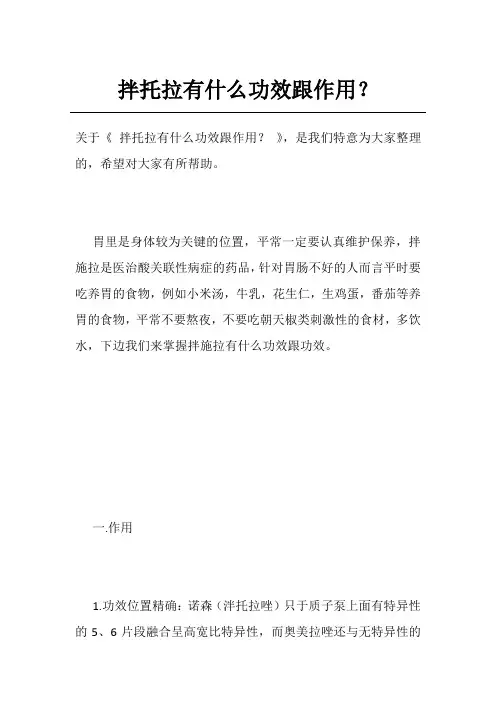
拌托拉有什么功效跟作用?关于《拌托拉有什么功效跟作用?》,是我们特意为大家整理的,希望对大家有所帮助。
胃里是身体较为关键的位置,平常一定要认真维护保养,拌施拉是医治酸关联性病症的药品,针对胃肠不好的人而言平时要吃养胃的食物,例如小米汤,牛乳,花生仁,生鸡蛋,番茄等养胃的食物,平常不要熬夜,不要吃朝天椒类刺激性的食材,多饮水,下边我们来掌握拌施拉有什么功效跟功效。
一.作用1.功效位置精确:诺森(泮托拉唑)只于质子泵上面有特异性的5、6片段融合呈高宽比特异性,而奥美拉唑还与无特异性的7、8片段融合,兰索拉唑还与无特异性的7、8片段和3片段融合。
2.药品相互影响少:诺森不影响肝脏体细胞P450酶系的特异性,不与另外服食的氨茶碱、比索洛尔片、地高辛、华法令、硝苯吡啶、紧急避孕、苯妥英钠、优降糖、咖啡碱、双氯灭痛、安替比林、氟苯咪嗪产生相互影响。
3.十二指肠溃疡和胃溃疡应用泮托拉唑与奥美拉唑医治的痊愈率无显著差别,泮托拉唑的耐受力更强。
4.诺森对各种各样原因导致的胃黏膜变病引发的上消化道出血功效与奥美拉唑无差别,副作用轻度,是医治上消化道出血可以信赖的药品之一。
二.生产适用范围疫苗酸关联性病症:包含十二指肠溃疡、胃溃疡、返流性食管炎和卓-艾综合征,非常是用以溃疡伴流血、呕吐或不可以进餐及其反复性溃疡和急性胰腺炎。
还可用以防止大手术治疗或比较严重创伤造成的应激性溃疡。
三.生产忌讳疫苗对本产品过敏症状、哺乳期间及孕妇禁止使用。
四.生产副作用疫苗少许头昏、失眠、总想睡觉、恶心想吐、腹泻、便秘、皮疹和肌肉疼痛等病症。
五.胃肠不好要多吃非常容易消化吸收的食材1.饮食搭配宜柔和、无刺激的食材,烹制时食材宜做得酥烂,碎小一些,便于消化和吸收。
食欲减退者,应少食多餐。
目地取决于降低胃肠的压力,且能摄入充足的营养成分。
2.适合正餐及豆类食品,鲜面条、馍馍、花卷馒头、吐司面包、小米、棒子面等。
肉、蛋、奶制品的挑选因挑选蛋白和优质蛋白质较少的,如少油腻感的牛肝、鹅肉等,牛乳要少喝,因为它是寒性,对胃有刺激效果。

泮托拉唑钠治疗消化溃疡合并消化道出血的药学研究发布时间:2022-01-18T05:58:46.295Z 来源:《世界复合医学》2021年12期作者:孙进哲[导读] 目的分析泮托拉唑钠在消化溃疡合并消化道出血治疗中的应用效果。
孙进哲绥化市第一医院 152000【摘要】目的分析泮托拉唑钠在消化溃疡合并消化道出血治疗中的应用效果。
方法随机选取本院68例消化溃疡合并消化道出血,时间选自2019年5月-2020年12月,随机分组,每组34例,对照组与观察组分别实施奥美拉唑与泮托拉唑钠治疗,对比治疗效果。
结果治疗总有效率方面,观察组是94.12%,对照组是76.47%,观察组比对照组高,差异显著(P<0.05)。
结论泮托拉唑钠在消化溃疡合并消化道出血治疗中应用效果显著,其有助于患者出血、溃疡等症状及早改善,促进整体治疗效果的提高,值得临床采纳、推广。
【关键词】消化溃疡;消化道出血;泮托拉唑钠[Abstract] Objective To analyze the effect of pantoprazole sodium in the treatment of peptic ulcer complicated with gastrointestinal bleeding. Methods 68 cases of peptic ulcer complicated with gastrointestinal bleeding were randomly selected from May 2019 to December 2020. They were randomly divided into 34 cases in each group. The control group and the observation group were treated with omeprazole and pantoprazole sodium respectively. Results the total effective rate of the observation group was 94.12% and that of the control group was 76.47%, which was significantly higher than that of the control group (P < 0.05). Conclusion pantoprazole sodium is effective in the treatment of peptic ulcer complicated with gastrointestinal bleeding. It helps to improve the symptoms of bleeding and ulcer as soon as possible and promote the overall treatment effect. It is worthy of clinical adoption and promotion.【 key words 】 peptic ulcer; Gastrointestinal bleeding; Pantoprazole sodium消化溃疡是临床发生率较高的一种疾病,消化道出血是消化溃疡常见并发症之一,具有呕吐、腹部不适、黑便、腹痛等症状【1】。
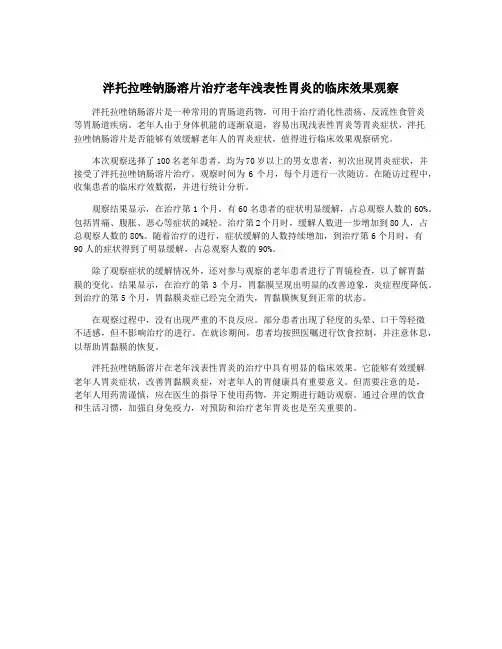
泮托拉唑钠肠溶片治疗老年浅表性胃炎的临床效果观察泮托拉唑钠肠溶片是一种常用的胃肠道药物,可用于治疗消化性溃疡、反流性食管炎等胃肠道疾病。
老年人由于身体机能的逐渐衰退,容易出现浅表性胃炎等胃炎症状,泮托拉唑钠肠溶片是否能够有效缓解老年人的胃炎症状,值得进行临床效果观察研究。
本次观察选择了100名老年患者,均为70岁以上的男女患者,初次出现胃炎症状,并接受了泮托拉唑钠肠溶片治疗。
观察时间为6个月,每个月进行一次随访。
在随访过程中,收集患者的临床疗效数据,并进行统计分析。
观察结果显示,在治疗第1个月,有60名患者的症状明显缓解,占总观察人数的60%。
包括胃痛、腹胀、恶心等症状的减轻。
治疗第2个月时,缓解人数进一步增加到80人,占总观察人数的80%。
随着治疗的进行,症状缓解的人数持续增加,到治疗第6个月时,有90人的症状得到了明显缓解,占总观察人数的90%。
除了观察症状的缓解情况外,还对参与观察的老年患者进行了胃镜检查,以了解胃黏膜的变化。
结果显示,在治疗的第3个月,胃黏膜呈现出明显的改善迹象,炎症程度降低。
到治疗的第5个月,胃黏膜炎症已经完全消失,胃黏膜恢复到正常的状态。
在观察过程中,没有出现严重的不良反应。
部分患者出现了轻度的头晕、口干等轻微不适感,但不影响治疗的进行。
在就诊期间,患者均按照医嘱进行饮食控制,并注意休息,以帮助胃黏膜的恢复。
泮托拉唑钠肠溶片在老年浅表性胃炎的治疗中具有明显的临床效果。
它能够有效缓解老年人胃炎症状,改善胃黏膜炎症,对老年人的胃健康具有重要意义。
但需要注意的是,老年人用药需谨慎,应在医生的指导下使用药物,并定期进行随访观察。
通过合理的饮食和生活习惯,加强自身免疫力,对预防和治疗老年胃炎也是至关重要的。
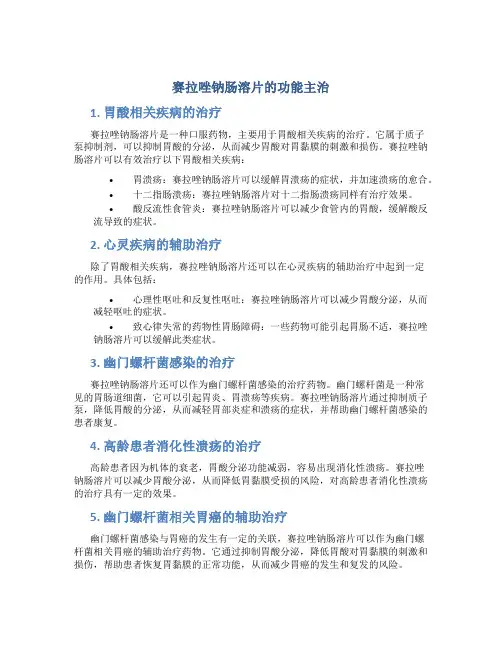
赛拉唑钠肠溶片的功能主治1. 胃酸相关疾病的治疗赛拉唑钠肠溶片是一种口服药物,主要用于胃酸相关疾病的治疗。
它属于质子泵抑制剂,可以抑制胃酸的分泌,从而减少胃酸对胃黏膜的刺激和损伤。
赛拉唑钠肠溶片可以有效治疗以下胃酸相关疾病:•胃溃疡:赛拉唑钠肠溶片可以缓解胃溃疡的症状,并加速溃疡的愈合。
•十二指肠溃疡:赛拉唑钠肠溶片对十二指肠溃疡同样有治疗效果。
•酸反流性食管炎:赛拉唑钠肠溶片可以减少食管内的胃酸,缓解酸反流导致的症状。
2. 心灵疾病的辅助治疗除了胃酸相关疾病,赛拉唑钠肠溶片还可以在心灵疾病的辅助治疗中起到一定的作用。
具体包括:•心理性呕吐和反复性呕吐:赛拉唑钠肠溶片可以减少胃酸分泌,从而减轻呕吐的症状。
•致心律失常的药物性胃肠障碍:一些药物可能引起胃肠不适,赛拉唑钠肠溶片可以缓解此类症状。
3. 幽门螺杆菌感染的治疗赛拉唑钠肠溶片还可以作为幽门螺杆菌感染的治疗药物。
幽门螺杆菌是一种常见的胃肠道细菌,它可以引起胃炎、胃溃疡等疾病。
赛拉唑钠肠溶片通过抑制质子泵,降低胃酸的分泌,从而减轻胃部炎症和溃疡的症状,并帮助幽门螺杆菌感染的患者康复。
4. 高龄患者消化性溃疡的治疗高龄患者因为机体的衰老,胃酸分泌功能减弱,容易出现消化性溃疡。
赛拉唑钠肠溶片可以减少胃酸分泌,从而降低胃黏膜受损的风险,对高龄患者消化性溃疡的治疗具有一定的效果。
5. 幽门螺杆菌相关胃癌的辅助治疗幽门螺杆菌感染与胃癌的发生有一定的关联,赛拉唑钠肠溶片可以作为幽门螺杆菌相关胃癌的辅助治疗药物。
它通过抑制胃酸分泌,降低胃酸对胃黏膜的刺激和损伤,帮助患者恢复胃黏膜的正常功能,从而减少胃癌的发生和复发的风险。
结论赛拉唑钠肠溶片是一种有效的质子泵抑制剂,主要用于胃酸相关疾病的治疗。
它可以减少胃酸分泌,缓解胃溃疡、十二指肠溃疡、酸反流性食管炎等疾病的症状。
此外,赛拉唑钠肠溶片还可以在心灵疾病、幽门螺杆菌感染、高龄患者消化性溃疡和幽门螺杆菌相关胃癌的辅助治疗中发挥一定的作用。
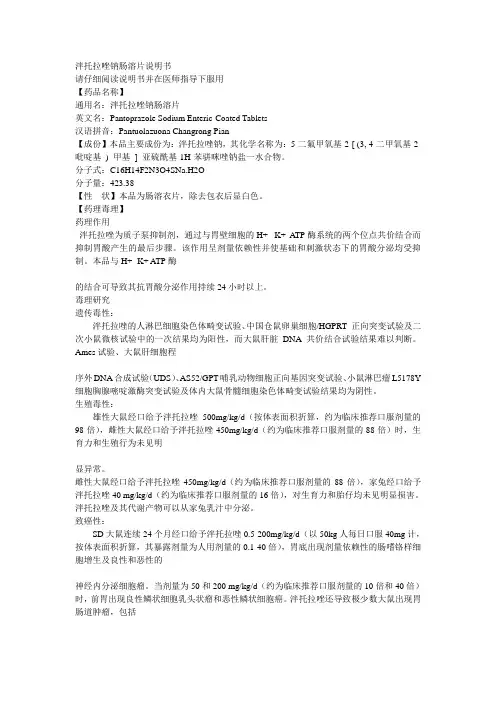
泮托拉唑钠肠溶片说明书请仔细阅读说明书并在医师指导下服用【药品名称】通用名:泮托拉唑钠肠溶片英文名:Pantoprazole Sodium Enteric-Coated Tablets汉语拼音:Pantuolazuona Changrong Pian【成份】本品主要成份为:泮托拉唑钠,其化学名称为:5-二氟甲氧基-2-[ (3, 4-二甲氧基-2-吡啶基) 甲基] 亚硫酰基-1H-苯骈咪唑钠盐一水合物。
分子式:C16H14F2N3O4SNa.H2O分子量:423.38【性状】本品为肠溶衣片,除去包衣后显白色。
【药理毒理】药理作用泮托拉唑为质子泵抑制剂,通过与胃壁细胞的H+ -K+ ATP酶系统的两个位点共价结合而抑制胃酸产生的最后步骤。
该作用呈剂量依赖性并使基础和刺激状态下的胃酸分泌均受抑制。
本品与H+ -K+ ATP酶的结合可导致其抗胃酸分泌作用持续24小时以上。
毒理研究遗传毒性:泮托拉唑的人淋巴细胞染色体畸变试验、中国仓鼠卵巢细胞/HGPRT 正向突变试验及二次小鼠微核试验中的一次结果均为阳性,而大鼠肝脏DNA共价结合试验结果难以判断。
Ames试验、大鼠肝细胞程序外DNA合成试验(UDS)、AS52/GPT哺乳动物细胞正向基因突变试验、小鼠淋巴瘤L5178Y 细胞胸腺嘧啶激酶突变试验及体内大鼠骨髓细胞染色体畸变试验结果均为阴性。
生殖毒性:雄性大鼠经口给予泮托拉唑500mg/kg/d(按体表面积折算,约为临床推荐口服剂量的98倍),雌性大鼠经口给予泮托拉唑450mg/kg/d(约为临床推荐口服剂量的88倍)时,生育力和生殖行为未见明显异常。
雌性大鼠经口给予泮托拉唑450mg/kg/d(约为临床推荐口服剂量的88倍),家兔经口给予泮托拉唑40 mg/kg/d(约为临床推荐口服剂量的16倍),对生育力和胎仔均未见明显损害。
泮托拉唑及其代谢产物可以从家兔乳汁中分泌。
致癌性:SD大鼠连续24个月经口给予泮托拉唑0.5-200mg/kg/d(以50kg人每日口服40mg计,按体表面积折算,其暴露剂量为人用剂量的0.1-40倍),胃底出现剂量依赖性的肠嗜铬样细胞增生及良性和恶性的神经内分泌细胞瘤。
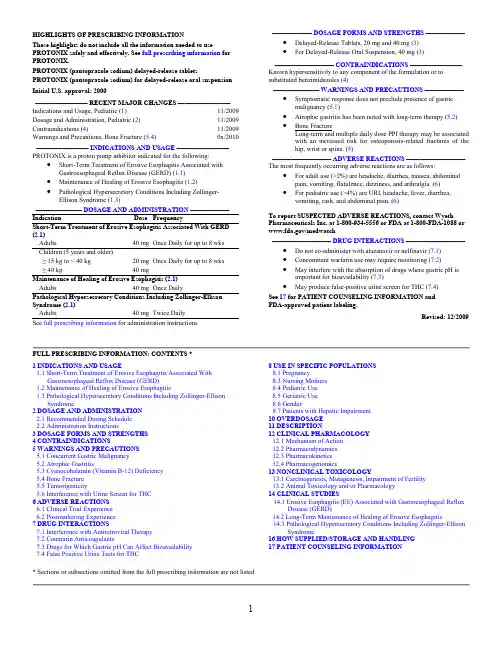
HIGHLIGHTS OF PRESCRIBING INFORMATIONThese highlights do not include all the information needed to use PROTONIX safely and effectively. See full prescribing information for PROTONIX.PROTONIX (pantoprazole sodium) delayed-release tablets PROTONIX (pantoprazole sodium) for delayed-release oral suspension Initial U.S. approval: 2000———————— RECENT MAJOR CHANGES ———————— Indications and Usage, Pediatric (1) 11/2009 Dosage and Administration, Pediatric (2) 11/2009 Contraindications (4) 11/2009 Warnings and Precautions, Bone Fracture (5.4) 0x/2010 ———————— INDICATIONS AND USAGE ———————— PROTONIX is a proton pump inhibitor indicated for the following: ∙Short-Term Treatment of Erosive Esophagitis Associated with Gastroesophageal Reflux Disease (GERD) (1.1)∙Maintenance of Healing of Erosive Esophagitis (1.2)∙Pathological Hypersecretory Conditions Including Zollinger-Ellison Syndrome (1.3)——————— DOSAGE AND ADMINISTRATION ——————Indication Dose FrequencyShort-Term Treatment of Erosive Esophagitis Associated With GERD (2.1)Adults 40 mg Once Daily for up to 8 wks Children (5 years and older)≥ 15 kg to < 40 kg 20 mg Once Daily for up to 8 wks≥ 40 kg 40 mgMaintenance of Healing of Erosive Esophagitis (2.1)Adults 40 mg Once DailyPathological Hypersecretory Conditions Including Zollinger-Ellison Syndrome (2.1)Adults 40 mg Twice DailySee full prescribing information for administration instructions—————— DOSAGE FORMS AND STRENGTHS —————— ∙Delayed-Release Tablets, 20 mg and 40 mg (3)∙For Delayed-Release Oral Suspension, 40 mg (3) ————————— CONTRAINDICATIONS ———————— Known hypersensitivity to any component of the formulation or to substituted benzimidazoles (4)——————— WARNINGS AND PRECAUTIONS —————— ∙Symptomatic response does not preclude presence of gastric malignancy (5.1)∙Atrophic gastritis has been noted with long-term therapy (5.2)∙ Bone FractureLong-term and multiple daily dose PPI therapy may be associatedwith an increased risk for osteoporosis-related fractures of thehip, wrist or spine. (5)————————— ADVERSE REACTIONS ————————— The most frequently occurring adverse reactions are as follows: ∙For adult use (>2%) are headache, diarrhea, nausea, abdominal pain, vomiting, flatulence, dizziness, and arthralgia. (6) ∙For pediatric use (>4%) are URI, headache, fever, diarrhea, vomiting, rash, and abdominal pain. (6)To report SUSPECTED ADVERSE REACTIONS, contact Wyeth Pharmaceuticals Inc. at 1-800-934-5556 or FDA at 1-800-FDA-1088 or /medwatch————————— DRUG INTERACTIONS ————————— ∙Do not co-administer with atazanavir or nelfinavir (7.1)∙Concomitant warfarin use may require monitoring (7.2)∙May interfere with the absorption of drugs where gastric pH is important for bioavailability (7.3)∙May produce false-positive urine screen for THC (7.4)See 17 for PATIENT COUNSELING INFORMATION andFDA-approved patient labeling.Revised: 12/2009FULL PRESCRIBING INFORMATION: CONTENTS *1 INDICATIONS AND USAGE1.1 Short-Term Treatment of Erosive Esophagitis Associated WithGastroesophageal Reflux Disease (GERD)1.2 Maintenance of Healing of Erosive Esophagitis1.3 Pathological Hypersecretory Conditions Including Zollinger-EllisonSyndrome2 DOSAGE AND ADMINISTRATION2.1 Recommended Dosing Schedule2.2 Administration Instructions3 DOSAGE FORMS AND STRENGTHS4 CONTRAINDICATIONS5 WARNINGS AND PRECAUTIONS5.1 Concurrent Gastric Malignancy5.2 Atrophic Gastritis5.3 Cyanocobalamin (Vitamin B-12) Deficiency5.4 Bone Fracture5.5 Tumorigenicity5.6 Interference with Urine Screen for THC6 ADVERSE REACTIONS6.1 Clinical Trial Experience6.2 Postmarketing Experience7 DRUG INTERACTIONS7.1 Interference with Antiretroviral Therapy7.2 Coumarin Anticoagulants7.3 Drugs for Which Gastric pH Can Affect Bioavailability7.4 False Positive Urine Tests for THC* Sections or subsections omitted from the full prescribing information are not listed 8 USE IN SPECIFIC POPULATIONS8.1 Pregnancy8.3 Nursing Mothers8.4 Pediatric Use8.5 Geriatric Use8.6 Gender8.7 Patients with Hepatic Impairment10 OVERDOSAGE11 DESCRIPTION12 CLINICAL PHARMACOLOGY12.1 Mechanism of Action12.2 Pharmacodynamics12.3 Pharmacokinetics12.4 Pharmacogenomics13 NONCLINICAL TOXICOLOGY13.1 Carcinogenesis, Mutagenesis, Impairment of Fertility13.2 Animal Toxicology and/or Pharmacology14 CLINICAL STUDIES14.1 Erosive Esophagitis (EE) Associated with Gastroesophageal RefluxDisease (GERD)14.2 Long-Term Maintenance of Healing of Erosive Esophagitis14.3 Pathological Hypersecretory Conditions Including Zollinger-EllisonSyndrome16 HOW SUPPLIED/STORAGE AND HANDLING17 PATIENT COUNSELING INFORMATIONFULL PRESCRIBING INFORMATION1 INDICATIONS AND USAGEPROTONIX For Delayed-Release Oral Suspension and PROTONIX Delayed-Release Tablets are indicated for:1.1 Short-Term Treatment of Erosive Esophagitis Associated With Gastroesophageal Reflux Disease (GERD)PROTONIX is indicated in adults and pediatric patients five years of age and older for the short-term treatment (up to 8 weeks) in the healing and symptomatic relief of erosive esophagitis. For those adult patients who have not healed after 8 weeks of treatment, an additional 8-week course of PROTONIX may be considered. Safety of treatment beyond 8 weeks in pediatric patients has not been established.1.2 Maintenance of Healing of Erosive EsophagitisPROTONIX is indicated for maintenance of healing of erosive esophagitis and reduction in relapse rates of daytime and nighttime heartburn symptoms in adult patients with GERD. Controlled studies did not extend beyond 12 months.1.3 Pathological Hypersecretory Conditions Including Zollinger-Ellison Syndrome PROTONIX is indicated for the long-term treatment of pathological hypersecretory conditions, including Zollinger-Ellison syndrome.2 DOSAGE AND ADMINISTRATION2.1 Recommended Dosing SchedulePROTONIX is supplied as delayed-release granules in packets for preparation of oral suspensions or as delayed-release tablets. The recommended dosages are outlined in Table 1.Table 1: Recommended Dosing Schedule for PROTONIXIndication Dose FrequencyShort-Term Treatment of Erosive Esophagitis Associated With GERDAdults 40 mg Once daily for up to 8 weeks*Children (5 years and older)≥ 15 kg to < 40 kg 20 mg Once daily for up to 8 weeks≥ 40 kg 40 mgMaintenance of Healing of Erosive EsophagitisAdults 40 mg Once dailyPathological Hypersecretory Conditions Including Zollinger-Ellison SyndromeAdults 40 mg Twice daily*** For adult patients who have not healed after 8 weeks of treatment, an additional 8-week course of PROTONIX may be considered.** Dosage regimens should be adjusted to individual patient needs and should continue for as long as clinically indicated. Doses up to 240 mg daily have been administered.2.2 Administration InstructionsDirections for method of administration for each dosage form are presented in Table 2.Table 2: Administration InstructionsFormulation Route Instructions*Delayed-Release TabletsFor Delayed-Release Oral Administered in 1 teaspoonful of applesauce or apple Oral Suspension juice approximately 30 minutes prior to a mealFor Delayed-Release Nasogastric See instructions belowOral Suspension tube* Patients should be cautioned that PROTONIX Delayed-Release Tablets and PROTONIX For Delayed-Release Oral Suspension should not be split, chewed, or crushed.PROTONIX Delayed-Release TabletsPROTONIX Delayed-Release Tablets should be swallowed whole, with or without food in the stomach. If patients are unable to swallow a 40 mg tablet, two 20 mg tablets may be taken. Concomitant administration of antacids does not affect the absorption of PROTONIXDelayed-Release Tablets.PROTONIX For Delayed-Release Oral SuspensionPROTONIX For Delayed-Release Oral Suspension should only be administered approximately 30 minutes prior to a meal via oral administration in apple juice or applesauce or nasogastric tube in apple juice only. Because proper pH is necessary for stability, do not administer PROTONIX For Delayed-Release Oral Suspension in liquids other than apple juice, or foods other than applesauce.Do not divide the 40 mg PROTONIX For Delayed-Release Oral Suspension packet to create a 20 mg dosage for pediatric patients who are unable to take the tablet formulation. PROTONIX For Delayed-Release Oral Suspension - Oral Administration in Applesauce∙Open packet.∙Sprinkle granules on one teaspoonful of applesauce. DO NOT USE OTHER FOODS OR CRUSH OR CHEW THE GRANULES.∙Take within 10 minutes of preparation.∙Take sips of water to make sure granules are washed down into the stomach. Repeat water sips as necessary.PROTONIX For Delayed-Release Oral Suspension - Oral Administration in Apple Juice∙Open packet.∙Empty granules into a small cup or teaspoon containing one teaspoon of apple juice.∙Stir for 5 seconds (granules will not dissolve) and swallow immediately.∙To make sure that the entire dose is taken, rinse the container once or twice with apple juice to remove any remaining granules. Swallow immediately.PROTONIX For Delayed-Release Oral Suspension - Nasogastric (NG) Tube or Gastrostomy Tube AdministrationFor patients who have a nasogastric tube or gastrostomy tube in place, PROTONIX For Delayed-Release Oral Suspension can be given as follows:∙Remove the plunger from the barrel of a 2 ounce (60 mL) catheter-tip syringe. Discard the plunger.∙Connect the catheter tip of the syringe to a 16 French (or larger) tube.∙Hold the syringe attached to the tubing as high as possible while giving PROTONIX For Delayed-Release Oral Suspension to prevent any bending of the tubing.∙Empty the contents of the packet into the barrel of the syringe.∙ Add 10 mL (2 teaspoonfuls) of apple juice and gently tap and/or shake the barrel of the syringe to help rinse the syringe and tube. Repeat at least twice more using the sameamount of apple juice (10 mL or 2 teaspoonfuls) each time. No granules should remain in the syringe.3 DOSAGE FORMS AND STRENGTHSDelayed-Release Tablets:∙40 mg, yellow oval biconvex tablets imprinted with PROTONIX (brown ink) on one side∙20 mg, yellow oval biconvex tablets imprinted with P20 (brown ink) on one sideFor Delayed-Release Oral Suspension:40 mg, pale yellowish to dark brownish, enteric-coated granules in a unit dose packet4 CONTRAINDICATIONSPROTONIX is contraindicated in patients with known hypersensitivity to any component of the formulation [see Description (11)] or any substituted benzimidazole.5 WARNINGS AND PRECAUTIONS5.1 Concurrent Gastric MalignancySymptomatic response to therapy with PROTONIX does not preclude the presence of gastric malignancy.5.2 Atrophic GastritisAtrophic gastritis has been noted occasionally in gastric corpus biopsies from patients treated long-term with PROTONIX, particularly in patients who were H. pylori positive.5.3 Cyanocobalamin (Vitamin B-12) DeficiencyGenerally, daily treatment with any acid-suppressing medications over a long period of time (e.g., longer than 3 years) may lead to malabsorption of cyanocobalamin (Vitamin B-12) caused by hypo- or achlorhydria. Rare reports of cyanocobalamin deficiency occurring with acid-suppressing therapy have been reported in the literature. This diagnosis should be considered if clinical symptoms consistent with cyanocobalamin deficiency are observed.5.4 Bone FractureSeveral published observational studies suggest that proton pump inhibitor (PPI) therapy may be associated with an increased risk for osteoporosis-related fractures of the hip, wrist, or spine. The risk of fracture was increased in patients who received high-dose, defined as multiple daily doses, and long-term PPI therapy (a year or longer). Patients should use the lowest dose and shortest duration of PPI therapy appropriate to the condition being treated. Patients at risk for osteoporosis-related fractures should be managed according to established treatment guidelines [see Dosage and Administration (2) and Adverse Reactions (6.2)].5.5 TumorigenicityDue to the chronic nature of GERD, there may be a potential for prolonged administration of PROTONIX. In long-term rodent studies, pantoprazole was carcinogenic and caused rare types of gastrointestinal tumors. The relevance of these findings to tumor development in humans is unknown [see Nonclinical Toxicology (13.1)].5.6 Interference with Urine Screen for THCSee Drug Interactions (7.4).6 ADVERSE REACTIONSThe adverse reaction profiles for PROTONIX (pantoprazole sodium) For Delayed-Release Oral Suspension and PROTONIX (pantoprazole sodium) Delayed-Release Tablets are similar.6.1 Clinical Trial ExperienceBecause clinical trials are conducted under widely varying conditions, adverse reaction rates observed in the clinical trials of a drug cannot be directly compared to rates in the clinical trials of another drug and may not reflect the rates observed in clinical practice.AdultsSafety in nine randomized comparative US clinical trials in patients with GERD included 1,473 patients on oral PROTONIX (20 mg or 40 mg), 299 patients on an H2-receptor antagonist, 46 patients on another proton pump inhibitor, and 82 patients on placebo. The most frequently occurring adverse reactions are listed in Table 3.Table 3: Adverse Reactions Reported in Clinical Trials of Adult Patients with GERD at aFrequency of > 2%PROTONIX Comparators Placebo(n=1473) (n=345) (n=82)% %% Headache 12.2 12.8 8.5 Diarrhea 8.8 9.6 4.9 Nausea 7.0 5.2 9.8 Abdominal pain 6.2 4.1 6.1 Vomiting 4.3 3.5 2.4 Flatulence 3.9 2.9 3.7 Dizziness 3.0 2.9 1.2 Arthralgia 2.8 1.4 1.2 Additional adverse reactions that were reported for PROTONIX in clinical trials with a frequency of ≤ 2% are listed below by body system:Body as a Whole: allergic reaction, pyrexia, photosensitivity reaction, facial edema Gastrointestinal: constipation, dry mouth, hepatitisHematologic: leukopenia, thrombocytopeniaMetabolic/Nutritional: elevated CK (creatine kinase), generalized edema, elevated triglycerides, liver enzymes elevatedMusculoskeletal: myalgiaNervous: depression, vertigoSkin and Appendages: urticaria, rash, pruritusSpecial Senses: blurred visionPediatric PatientsSafety of PROTONIX in the treatment of Erosive Esophagitis (EE) associated with GERD was evaluated in pediatric patients ages 1 year through 16 years in three clinical trials. Safety trials involved pediatric patients with EE; however, as EE is uncommon in the pediatric population, 249 pediatric patients with endoscopically-proven or symptomatic GERD were also evaluated. All adult adverse reactions to PROTONIX are considered relevant to pediatric patients. In patients ages 1 year through 16 years, the most commonly reported (> 4%) adverse reactions include: URI, headache, fever, diarrhea, vomiting, rash, and abdominal pain.For safety information in patients less than 1 year of age see Use in Specific Populations (8.4). Additional adverse reactions that were reported for PROTONIX in pediatric patients in clinical trials with a frequency of ≤ 4% are listed below by body system:Body as a Whole: allergic reaction, facial edemaGastrointestinal: constipation, flatulence, nauseaMetabolic/Nutritional: elevated triglycerides, elevated liver enzymes, elevated CK (creatine kinase)Musculoskeletal: arthralgia, myalgiaNervous: dizziness, vertigoSkin and Appendages: urticariaThe following adverse reactions seen in adults in clinical trials were not reported in pediatric patients in clinical trials, but are considered relevant to pediatric patients: photosensitivity reaction, dry mouth, hepatitis, thrombocytopenia, generalized edema, depression, pruritus, leukopenia, and blurred vision.Zollinger-Ellison SyndromeIn clinical studies of Zollinger-Ellison Syndrome, adverse reactions reported in 35 patients taking PROTONIX 80 mg/day to 240 mg/day for up to 2 years were similar to those reported in adult patients with GERD.6.2 Postmarketing ExperienceThe following adverse reactions have been identified during postapproval use of PROTONIX. Because these reactions are reported voluntarily from a population of uncertain size, it is not always possible to reliably estimate their frequency or establish a causal relationship to drug exposure.These adverse reactions are listed below by body system:Immune System Disorders: anaphylaxis (including anaphylactic shock)Skin and Subcutaneous Tissue Disorders: severe dermatologic reactions (some fatal), including erythema multiforme, Stevens-Johnson syndrome, and toxic epidermal necrolysis (TEN, some fatal), and angioedema (Quincke’s edema)Musculoskeletal and Connective Tissue Disorders: rhabdomyolysis, bone fractureRenal and Urinary Disorders: interstitial nephritisHepatobiliary Disorders: hepatocellular damage leading to jaundice and hepatic failure Psychiatric Disorders: hallucination, confusion7 DRUG INTERACTIONS7.1 Interference with Antiretroviral TherapyConcomitant use of atazanavir or nelfinavir with proton pump inhibitors is not recommended. Coadministration of atazanavir or nelfinavir with proton pump inhibitors is expected to substantially decrease atazanavir or nelfinavir plasma concentrations and may result in a loss of therapeutic effect and development of drug resistance.7.2 Coumarin AnticoagulantsThere have been postmarketing reports of increased INR and prothrombin time in patients receiving proton pump inhibitors, including PROTONIX, and warfarin concomitantly. Increases in INR and prothrombin time may lead to abnormal bleeding and even death. Patients treated with proton pump inhibitors and warfarin concomitantly should be monitored for increases in INR and prothrombin time.7.3 Drugs for Which Gastric pH Can Affect BioavailabilityPantoprazole causes long-lasting inhibition of gastric acid secretion. Therefore, pantoprazole may interfere with absorption of drugs where gastric pH is an important determinant of their bioavailability (e.g., ketoconazole, ampicillin esters, and iron salts).7.4 False Positive Urine Tests for THCThere have been reports of false positive urine screening tests for tetrahydrocannabinol (THC) in patients receiving proton pump inhibitors. An alternative confirmatory method should be considered to verify positive results.8 USE IN SPECIFIC POPULATIONS8.1 PregnancyTeratogenic EffectsPregnancy Category BReproduction studies have been performed in rats at oral doses up to 88 times the recommended human dose and in rabbits at oral doses up to 16 times the recommended human dose and have revealed no evidence of impaired fertility or harm to the fetus due to pantoprazole. There are, however, no adequate and well-controlled studies in pregnant women. Because animal reproduction studies are not always predictive of human response, this drug should be used during pregnancy only if clearly needed [see Nonclinical Toxicology (13.2)]. 8.3 Nursing MothersPantoprazole and its metabolites are excreted in the milk of rats. Pantoprazole excretion in human milk has been detected in a study of a single nursing mother after a single 40 mg oral dose. The clinical relevance of this finding is not known. Many drugs which are excreted in human milk have a potential for serious adverse reactions in nursing infants. Based on the potential for tumorigenicity shown for pantoprazole in rodent carcinogenicity studies, a decision should be made whether to discontinue nursing or to discontinue the drug, taking into account the benefit of the drug to the mother.8.4 Pediatric UseThe safety and effectiveness of PROTONIX for short-term treatment (up to eight weeks) of erosive esophagitis (EE) associated with GERD have been established in pediatric patients 1 year through 16 years of age. Effectiveness for EE has not been demonstrated in patients less than 1 year of age. In addition, for patients less than 5 years of age, there is no appropriate dosage strength in an age-appropriate formulation available. Therefore, PROTONIX is indicated for the short-term treatment of EE associated with GERD for patients 5 years and older. The safety and effectiveness of PROTONIX for pediatric uses other than EE have not been established.1 year through 16 years of ageUse of PROTONIX in pediatric patients 1 year through 16 years of age for short-term treatment (up to eight weeks) of EE associated with GERD is supported by: a) extrapolation of results from adequate and well-controlled studies that supported the approval of PROTONIX for treatment of EE associated with GERD in adults, and b) safety, effectiveness, and pharmacokinetic studies performed in pediatric patients [see Clinical Studies (14.1), and Clinical Pharmacology (12.3)].Safety of PROTONIX in the treatment of EE associated with GERD in pediatric patients 1 through 16 years of age was evaluated in three multicenter, randomized, double-blind, parallel-treatment studies, involving 249 pediatric patients, including 8 with EE (4 patients ages 1 yearto 5 years and 4 patients 5 years to 11 years). The children ages 1 year to 5 years with endoscopically diagnosed EE (defined as an endoscopic Hetzel-Dent score ≥ 2) were treated once daily for 8 weeks with one of two dose levels of PROTONIX (approximating 0.6 mg/kg or 1.2 mg/kg). All 4 of these patients with EE were healed (Hetzel-Dent score of 0 or 1) at 8 weeks. Because EE is uncommon in the pediatric population, predominantly pediatric patients with endoscopically-proven or symptomatic GERD were also included in these studies. Patients were treated with a range of doses of PROTONIX once daily for 8 weeks. For safety findings see Adverse Reactions (6.1). Because these pediatric trials had no placebo, active comparator, or evidence of a dose response, the trials were inconclusive regarding the clinical benefit of PROTONIX for symptomatic GERD in the pediatric population. The effectiveness of PROTONIX for treating symptomatic GERD in pediatric patients has not been established. Although the data from the clinical trials support use of PROTONIX for the short-term treatment of EE associated with GERD in pediatric patients 1 year through 5 years, there is no commercially available dosage formulation appropriate for patients less than 5 years of age [see Dosage and Administration (2)].In a population pharmacokinetic analysis, clearance values in the children 1 to 5 years old with endoscopically proven GERD had a median value of 2.4 L/h. Following a 1.2 mg/kg equivalent dose (15 mg for ≤ 12.5 kg and 20 mg for > 12.5 to < 25 kg), the plasma concentrations of pantoprazole were highly variable and the median time to peak plasma concentration was 3 to 6 hours. The estimated AUC for patients 1 to 5 years old was 37% higher than for adults receiving a single 40 mg tablet, with a geometric mean AUC value of 6.8 µg•hr/mL. Neonates to less than one year of agePROTONIX was not found to be effective in a multicenter, randomized, double-blind, placebo-controlled, treatment-withdrawal study of 129 pediatric patients 1 through 11 months of age. Patients were enrolled if they had symptomatic GERD based on medical history and had not responded to non-pharmacologic interventions for GERD for two weeks. Patients received PROTONIX daily for four weeks in an open-label phase, then patients were randomized in equal proportion to receive PROTONIX treatment or placebo for the subsequent four weeks in a double-blind manner. Efficacy was assessed by observing the time from randomization to study discontinuation due to symptom worsening during the four-week treatment-withdrawal phase. There was no statistically significant difference between PROTONIX and placebo in the rate of discontinuation.In this trial, the adverse reactions that were reported more commonly (difference of ≥ 4%) in the treated population compared to the placebo population were elevated CK, otitis media, rhinitis, and laryngitis.In a population pharmacokinetic analysis, the systemic exposure was higher in patients less than 1 year of age with GERD compared to adults who received a single 40 mg dose (geometric mean AUC was 103% higher in preterm infants and neonates receiving single dose of 2.5 mg of PROTONIX, and 23% higher in infants 1 through 11 months of age receiving a single dose of approximately 1.2 mg/kg). In these patients, the apparent clearance (CL/F) increased with age (median clearance: 0.6 L/hr, range: 0.03 to 3.2 L/hr).These doses resulted in pharmacodynamic effects on gastric but not esophageal pH. Following once daily dosing of 2.5 mg of PROTONIX in preterm infants and neonates, there was an increase in the mean gastric pH (from 4.3 at baseline to 5.2 at steady-state) and in the mean % time that gastric pH was > 4 (from 60% at baseline to 80% at steady-state). Following once daily dosing of approximately 1.2 mg/kg of PROTONIX in infants 1 through 11 months of age, there was an increase in the mean gastric pH (from 3.1 at baseline to 4.2 at steady-state) and in the mean % time that gastric pH was > 4 (from 32% at baseline to 60% at steady-state). However, no significant changes were observed in mean intraesophageal pH or % time that esophageal pH was < 4 in either age group.Because PROTONIX was not shown to be effective in the randomized, placebo-controlled study in this age group, the use of PROTONIX for treatment of symptomatic GERD in infants less than 1 year of age is not indicated.8.5 Geriatric UseIn short-term US clinical trials, erosive esophagitis healing rates in the 107 elderly patients (≥ 65 years old) treated with PROTONIX were similar to those found in patients under the age of 65. The incidence rates of adverse reactions and laboratory abnormalities in patients aged 65 years and older were similar to those associated with patients younger than 65 years of age.8.6 GenderErosive esophagitis healing rates in the 221 women treated with PROTONIX Delayed-Release Tablets in US clinical trials were similar to those found in men. In the 122 women treatedlong-term with PROTONIX 40 mg or 20 mg, healing was maintained at a rate similar to that in men. The incidence rates of adverse reactions were also similar for men and women.8.7 Patients with Hepatic ImpairmentDoses higher than 40 mg/day have not been studied in patients with hepatic impairment [see Clinical Pharmacology (12.3)].10 OVERDOSAGEExperience in patients taking very high doses of PROTONIX (> 240 mg) is limited. Spontaneous post-marketing reports of overdose are generally within the known safety profile of PROTONIX.Pantoprazole is not removed by hemodialysis. In case of overdosage, treatment should be symptomatic and supportive.Single oral doses of pantoprazole at 709 mg/kg, 798 mg/kg, and 887 mg/kg were lethal to mice, rats, and dogs, respectively. The symptoms of acute toxicity were hypoactivity, ataxia, hunched sitting, limb-splay, lateral position, segregation, absence of ear reflex, and tremor.11 DESCRIPTIONThe active ingredient in PROTONIX (pantoprazole sodium) For Delayed-Release Oral Suspension and PROTONIX (pantoprazole sodium) Delayed-Release Tablets is a substituted benzimidazole, sodium 5-(difluoromethoxy)-2-[[(3,4-dimethoxy-2-pyridinyl)methyl] sulfinyl]-1H-benzimidazole sesquihydrate, a compound that inhibits gastric acid secretion. Its empirical formula is C16H14F2N3NaO4S x 1.5 H2O, with a molecular weight of 432.4. The structural formula is:Pantoprazole sodium sesquihydrate is a white to off-white crystalline powder and is racemic. Pantoprazole has weakly basic and acidic properties. Pantoprazole sodium sesquihydrate is freely soluble in water, very slightly soluble in phosphate buffer at pH 7.4, and practically insoluble in n-hexane.The stability of the compound in aqueous solution is pH-dependent. The rate of degradation increases with decreasing pH. At ambient temperature, the degradation half-life is approximately 2.8 hours at pH 5 and approximately 220 hours at pH 7.8.PROTONIX (pantoprazole sodium) is supplied as a for delayed-release oral suspension, available in one strength (40 mg), and as a delayed-release tablet, available in two strengths (20 mg and 40 mg).Each PROTONIX (pantoprazole sodium) Delayed-Release Tablet contains 45.1 mg or22.56 mg of pantoprazole sodium sesquihydrate (equivalent to 40 mg or 20 mg pantoprazole, respectively) with the following inactive ingredients: calcium stearate, crospovidone, hypromellose, iron oxide, mannitol, methacrylic acid copolymer, polysorbate 80, povidone, propylene glycol, sodium carbonate, sodium lauryl sulfate, titanium dioxide, and triethyl citrate. PROTONIX Delayed-Release Tablets (40 mg and 20 mg) complies with USP dissolution test 2.PROTONIX (pantoprazole sodium) For Delayed-Release Oral Suspension, 40 mg, contains the active ingredient pantoprazole sodium sesquihydrate in the form of enteric-coated granules in unit dose packets. Each unit dose packet contains enteric-coated granules containing 45.1 mg pantoprazole sodium sesquihydrate (equivalent to 40 mg of pantoprazole) with the following inactive ingredients: crospovidone, hypromellose, methacrylic acid copolymer, microcrystalline cellulose, polysorbate 80, povidone, sodium carbonate, sodium lauryl sulfate, talc, titanium dioxide, triethyl citrate, and yellow ferric oxide.。
来源快易捷医药网【药品名称】泮托拉唑钠肠溶片【英文名】Pantoprazole Sodium Enteric-Coated Tablets【汉语拼音】Pantuolazuona Changrongpian【主要成分】本品主要成份为泮托拉唑钠,其化学名称为5-二氟甲氧基-2-[[(3,4-二甲氧基-2-吡啶基)甲基]-亚磺酰基]-1H-苯并咪唑钠一水合物。
【化学结构式】【分子式】C16H14F2N3O4SNa·H2O【分子量】423.38【性状】本品为肠溶衣片,除去包衣后显白色。
【药理毒理】本品通过特异性地作用于胃粘膜壁细胞,降低壁细胞中的H+、K+-ATP酶的活性,从而抑制胃酸的分泌。
与奥美拉唑相比,本品对细胞色素P450酶的抑制作用较弱。
【药代动力学】本品口服后吸收迅速、完全,单次口服40mg后2~3小时左右即可达血药浓度峰值,其口服制剂的绝对生物利用度为77%,泮托拉唑的血浆蛋白结合率为98%,主要在肝脏代谢为去甲基泮托拉唑硫酸酯。
泮托拉唑的半衰期1小时左右,去甲基泮托拉唑硫酸酯的半衰期为1~5小时。
80%的代谢产物通过肾脏排出,其余经胆汁进入粪便排出。
【适应症】适用于活动性消化性溃疡(胃、十二指肠溃疡)、反流性食管炎和卓-艾氏综合征。
【用法用量】口服,每日早餐前40mg(1片),十二指肠溃疡疗程通常为2~4周,胃溃疡和反流性食管炎疗程通常为4~8周。
【不良反应】临床应用偶有头痛、头晕、失眠、嗜睡、恶心、腹痛、腹泻和便秘、腹胀、皮疹、肌肉疼痛等症状。
【禁忌】1.哺乳期妇女及妊娠三个月内妇女禁用。
2.对本品过敏者禁用。
【注意事项】1.本品为肠溶制剂,服用时请勿咀嚼。
2.当怀疑胃溃疡时,应首先排除癌症的可能性,因为本品治疗可减轻其症状,从而延误诊断。
3.肝肾功能不全者慎用,严重肝病时本品清除延缓,应减少用量。
4.本品不宜同时再服用其它抗酸剂和抑酸剂。
为防止抑酸过度,除卓-艾氏综合征外,建议用于消化性溃疡等病时,不宜大剂量长期应用。
泮托拉唑钠肠溶片说明书通用名:泮托拉唑钠肠溶片生产厂家: 湖北济安堂药业有限公司批准文号:国药准字H20214498药品规格:40mg*7片药品价格:¥16.5元【通用名称】泮托拉唑钠肠溶片【商品名称】泮托拉唑钠肠溶片【英文名称】PantoprazoleSodiumEnteric-CoatedTablets【拼音全码】PanTuoLaZuoNaChangRongPianQiLingTai【主要成份】泮托拉唑钠。
【性状】此产品为片剂。
【适应症/功能主治】适用于活动性消化性溃疡胃、十二指肠溃疡、反流动性食管炎和卓艾氏综合症。
【规格型号】40mg*7s【用法用量】十二指肠溃疡,胃溃疡和反流性食管炎,每日早晨口服一片。
十二指肠溃疡疗程通常为2~4周,胃溃疡和反流性食管炎疗程通常为4~8周。
【不良反应】尚不明确。
【禁忌】孕妇禁用。
【注意事项】1.忌食生冷、油腻食物。
2.哺乳期妇女慎用。
3.泮托拉唑钠肠溶片性状发生改变时禁止使用。
4.儿童必须在成人监护下使用。
5.请将泮托拉唑钠肠溶片放在儿童不能接触的地方。
【儿童用药】尚不明确。
【老年患者用药】泮托拉唑钠肠溶片未进行该项实验且无可靠参考文献。
【孕妇及哺乳期妇女用药】孕妇禁用。
【药物相互作用】如与其他药物同时使用可能会发生药物相互作用,详情请咨询医师或药师。
【药物过量】尚不明确。
【药理毒理】尚不明确。
【药代动力学】尚不明确。
【贮藏】密封,置阴凉干燥处。
【包装】40mg/s,7s/盒。
【有效期】24月【批准文号】国药准字H20214498【生产企业】湖北济安堂药业有限公司泮托拉唑钠肠溶片济安堂的功效与作用泮托拉唑钠肠溶片济安堂适用于活动性消化性溃疡胃、十二指肠溃疡、反流动性食管炎和卓艾氏综合症。
泮托拉唑钠肠溶片有哪些禁忌?药品禁忌的意思是必要用的时候利大于弊的时候可以应用,禁忌上所说的禁用,那么是绝对不可以用的,像慎用、忌用,都是可以根据病人的具体情况选择性应用。
核准日期:2007年02月24日修订日期:2013年02月19日2014年08月29日2016年11月28日2017年10月09日2019年08月09日泮托拉唑钠肠溶片40mg说明书请仔细阅读说明书并在医师指导下使用。
【药品名称】通用名称:泮托拉唑钠肠溶片商品名称:潘妥洛克®英文名称:Pantoprazole Sodium Enteric-Coated Tablets汉语拼音:Pan Tuo La Zuo Na Chang Rong Pian【成份】本品主要成份为:泮托拉唑(Pantoprazole)倍半水合钠盐。
化学名称:5-二氟甲氧基-2-[(3,4-二甲氧基-2-吡啶甲基)亚磺酰]-1-氢-苯并咪唑倍半水合钠盐化学结构式:分子式:C16H14F2N3NaO4S × 1.5H2O分子量:432.4【性状】本品为黄色肠溶衣片,除去包衣后显白色或类白色。
【适应症】-十二指肠溃疡-胃溃疡-中、重度反流性食管炎-与下述药物配伍用能够根除幽门螺杆菌感染:-克拉霉素和阿莫西林,或-克拉霉素和甲硝唑,或-阿莫西林和甲硝唑(详见用药方法)以减少该微生物感染所致的十二指肠溃疡与胃溃疡的复发。
提示泮托拉唑不用于治疗病变轻微的胃肠道疾患,如神经性消化不良。
在应用泮托拉唑治疗胃溃疡前,须除外胃与食道的恶性病变,以免因症状缓解而延误诊断。
反流性食管炎的诊断应经内镜检查核实。
【规格】40mg/片,每片潘妥洛克肠溶片含:45.1 mg 泮托拉唑倍半水合钠盐(相当于40mg泮托拉唑)。
【用法用量】本品若无医师特殊处方,应按下述方法服用,请遵守这些方法,否则可能疗效不佳。
对伴有幽门螺杆菌感染的十二指肠溃疡或胃溃疡须用联合疗法根除感染。
泮托拉唑与抗菌药物的联合使用可采取下述任何一种方案:a.1片泮托拉唑钠肠溶片× 2次/日+ 1000 mg 阿莫西林× 2次/日 + 500 mg 克拉霉素× 2次/日b. 1片泮托拉唑钠肠溶片× 2次/日+ 500 mg甲硝唑× 2次/日+ 500 mg克拉霉素× 2次/日c.1片泮托拉唑钠肠溶片× 2次/日+ 1000 mg阿莫西林× 2次/日+ 500 mg甲硝唑× 2次/日在联合疗法中,有甲硝唑的方案仅在其他方案不能根除幽门螺杆菌感染的情况下方予使用。